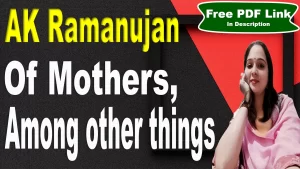Essay Type Questions
Write the critical appreciation of the poem “Obituary” by AK Ramanujan.
Introduction:
Obituary by A. K. Ramanujan is a poem that reflects on the death of the poet’s father and what he left behind. Ramanujan shares personal memories while talking about Indian traditions and the reality of life and death. The poem is simple but deep, showing how a father’s life can be remembered in small, everyday ways.
Central Idea:
The main idea of the poem is how the father’s death affected the family and how little recognition he received from the world. It shows that while family members remember him through rituals and memories, society often forgets people quickly.
Structure & Rhyme Scheme:
The poem is written in free verse, which means it doesn’t follow a specific rhyme or rhythm. This makes the poem sound more like a natural conversation or thought process. The structure fits the theme of the poem, showing the unpredictable nature of life and grief.
Themes:
Impermanence of Life: Life and achievements can be easily forgotten. The father’s life is reduced to just a short obituary in a newspaper.
Family Responsibility: The poem shows how family members have to perform traditional rituals after a death, like handling the father’s ashes.
Memory and Loss: The poet looks for traces of his father’s life, showing how personal loss stays with us even when others forget.
Cultural Traditions: The poem includes Indian customs, such as cremation and funeral rituals, showing their importance in dealing with death.
Sacred and Ordinary: The poem mixes big events like death with everyday things, like buying groceries, showing that life goes on even after loss.
Style:
Ramanujan’s style in this poem is simple, using everyday language and clear descriptions. He mixes serious moments with a touch of dry humor, making the poem feel both personal and relatable.
Poetic Devices:
Imagery: The poem uses images like “dust on a table of papers” and “spinal discs, rough” to paint clear pictures of death and rituals.
Symbolism: Items like “eye coins” symbolize funeral traditions, and the “house that leaned on a bent coconut tree” represents life’s struggles.
Irony: It’s ironic that the father’s life is summed up in just a few lines in a newspaper, which later becomes wrapping for groceries.
Enjambment: The poem flows from one line to the next without stopping, like life continuing after death.
Contrast: The poem shows the difference between the importance of death and the normal activities of life, like buying groceries.
Critical Commentary:
Scholars and literary critics often praise Ramanujan for his ability to blend the personal and the cultural. According to critic Bruce King, Ramanujan’s poetry, including Obituary, “balances the traditional and the modern, the public and the private.” His unique voice captures the tensions between heritage and individual experiences. Additionally, Ramanujan’s use of irony has been noted as a powerful tool for illustrating the gap between societal expectations and personal realities.
Message:
The poem’s message is that life is short and people can be forgotten easily, but family and traditions help keep memories alive. While society may overlook a person’s life, their family keeps honoring them through rituals and memories.
Conclusion:
Obituary is a simple yet powerful poem that talks about death, memory, and family. Ramanujan uses free verse and clear images to show how life goes on, even after a big loss. The poem reminds readers that, although life is temporary, memories live on through family and traditions.
Long note on themes of obituary by AK Ramanujan.
Impermanence of Life: The poem portrays the fleeting nature of life and how quickly people are forgotten. The father’s death, marked by a brief, unnoticed obituary in a local newspaper, symbolizes how human existence often lacks a lasting impact. The line “no longstanding headstone with his full name and two dates” emphasizes the absence of a tangible legacy. The obituary, reduced to two lines, soon becomes part of grocery wrapping sold by the kilo, further highlighting how even important life events become trivialized with time.
Family Duty: The poem reflects the responsibilities placed on family members after a loved one’s death. The sons perform traditional rituals, picking up the father’s remains and facing east as instructed by the priest. This emphasizes the significance of fulfilling one’s obligations within the family and community. The detailed description of the cremation process shows how these duties are essential for respecting the deceased and maintaining family honor.
Memory and Loss: Ramanujan explores how personal grief contrasts with society’s indifference. The poet reads the newspaper cones “for fun” but also “in the hope of finding these obituary lines,” suggesting a longing for connection and the need to hold onto memories. While the outside world quickly forgets the father, the family continues to feel the emotional weight of his absence. This theme underscores that while public acknowledgment fades, personal memories and their impact linger.
Cultural Rituals: The poem is rich in references to Indian funeral practices, such as cremation and the use of eye coins to guide the soul. Facing east during rituals and the description of the confluence of rivers signify the importance of tradition in Hindu beliefs. The cultural context adds depth to the narrative, showing how these rituals help the family process their grief and maintain a connection to their heritage.
Ordinary vs. Sacred: The juxtaposition of sacred rituals with everyday life underscores the theme of life’s routine nature. While the father’s cremation is a deeply significant event for the family, the obituary eventually becomes part of the mundane act of buying groceries wrapped in newspaper. This highlights how the profound and the ordinary coexist, and how even sacred moments are absorbed into the flow of daily life.
Change and Tradition: The poem suggests that death not only changes the family structure but also initiates traditions that keep the deceased’s memory alive. The poet notes that the father left them “a changed mother and more than one annual ritual,” showing how his death reshaped their lives. These rituals symbolize the continuity of memory, even as life evolves. The family must adapt to these changes while upholding traditions that honor the father’s legacy.










